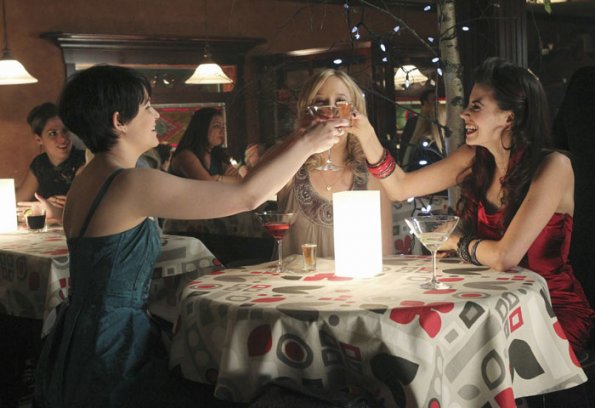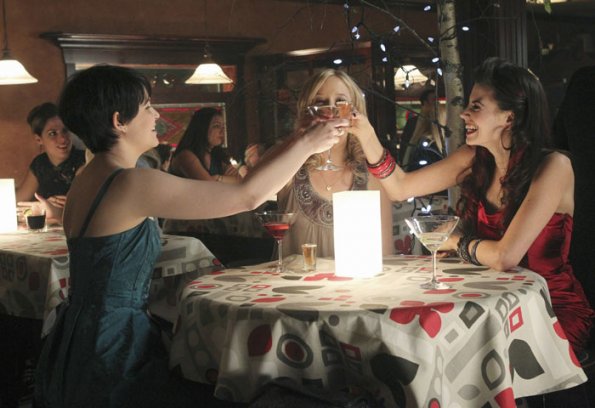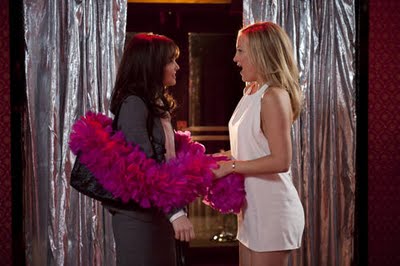This guest post by Emma Thomas appears as part of our theme week on Violent Women.
When Once Upon a Time, ABC’s fairytale drama, premiered in 2011, the focus was on Ginnifer Goodwin, fresh off her success on Big Love, and Jennifer Morrison, of House M.D. fame. Yet, fairly quickly, Lana Parrilla became the breakout star.
Morrison plays Emma Swan, arguably the series’ hero, while Goodwin plays her mother, Snow White (it’s complicated). Parrilla plays the show’s antagonist, Regina Mills, otherwise known as The Evil Queen.
Parrilla’s character is like no other on television.
Once Upon a Time flashes back and forth between the characters’ fairytale background in the Enchanted Forest and their modern existence in Storybrooke, Maine.
In Storybrooke, Regina Mills is powerful and complex. With her short hair, power suit, and subdued make-up, she looks every part a business woman. It is not only her clothing that illustrates her control, but also her attitude. She is cold and collected and judgmental from the very moment the show begins.
Back in the Enchanted Forest, Regina Mills is certainly not an in-control business woman, instead she is a violent, sadistic queen, with costuming to match. We see her command mass murders, and even rip out hearts. Regina Mills earns her Evil Queen moniker.
In the present, particularly during the show’s first two seasons, Regina Mills could not be qualified as a “good person” (a title the show adores). She is still manipulative, and still seeking a way to gain control. However, it is important to note, that unlike her sometimes nemesis, sometimes mentor, Rumplestiltskin, it is not power she seeks but control. It is always about control.
This makes sense when one considers Regina’s past. Abused as a child, forced to watch her mother murder her lover, and ordered into a marriage with a king who she physically could not escape, Regina’s tendency toward violence seems almost excusable.
Yet, interestingly enough, the show rarely addresses the connection between Regina’s past and her tendency toward violence. Her background is introduced slowly, and the audience is left to form their own conclusions.
In the past, Regina’s path to control is lined with dark magic. Dark magic is fueled by her anger, and the two intersect endlessly until it is hard to tell whether Regina is controlling the anger, or the anger is controlling her. What is definitive is that the more her power grows the more violent she becomes. With the only person who offered her a loving future dead, there is no one to rein her in.
The one person she has a connection with is her father, a kind man who did nothing to stop her mother’s abuse, but ultimately Regina’s increasingly violent nature wins out — and she murders her father in an attempt to gain more control.
In the present, Regina Mills finally finds inspiration to curb her violent nature. Her adoptive son Henry begs her to become ‘a good person’, and she tries her hardest to make him proud.
At face value Once Upon a Time is a very black and white show, and characters are either “good” or “bad.” Is it possible to change sides? Ultimately, yes, if we believe Captain Hook’s rapid ascension into the good guy club. But, Regina’s journey has not been so easy. Perhaps this is partly due to the fact that Regina herself would state that she is unequivocally bad.
Normally, the bad characters are hated, or at least seriously disliked, by viewers. Just look at William Lewis on Law and Order: SVU or Walder Frey on Game of Thrones. Generally, viewers love to hate evil characters.
Yet, on Once Upon a Time, most viewers love to love Regina Mills. Her violent past is excused by many as just that, the past. Interestingly enough, her violent present certainly exists. In the first season alone she murders a man, she kidnaps a woman, and she (accidentally but still) poisons her own son. Her behavior gradually change as the show progresses, although her acts do not become less violent. Instead, Regina begins to focus less on what she wants internally, and more on what is she, and most notably the good guys, deem is best for the greater good — but even when she’s being good she continues to fight, manipulate, and scheme. Somehow, this behavior is now acceptable, because she is helping the heroes and not the villains.
Why do we, as viewers, accept Regina Mills when her violence is partnered with good characters, but deem her evil when we are told, by the series’ writers, that she is bad? Of course, there are some differences. She hasn’t ordered a mass murder since she became “good.” But, could that be due more to a difference of time period? When the army of flying monkeys was attacking (yes, this show is often weird), the good characters considered it perfectly acceptable for Regina to murder them — and yes, it was murder, because we’d learned that the flying monkeys were human beings placed under a spell. So, mass murder is acceptable when it is in support of good.
Although Once Upon a Time itself does not directly address the complex questions of morality, it does raise them. Why is it acceptable for Regina Mills to kill at all? What is the true differentiation between good and bad? What makes someone evil? Regina was subjected to years of abuse, does that mean her attempt to murder her mother is justified?
And, when years later, Snow forces her to murder her mother, is that OK?
Presumably when she was forced into a marriage with Snow’s father, King Leopold, she was truly forced, likely sexually (this is one of many intense arguments within the fandom). Does that mean it was acceptable to orchestrate his murder?
Why is that worse than attempting to fight, presumably to the death, her own sister. Does the fact that she was was trying to harm Henry and Snow’s baby son make it acceptable?
In many ways, Regina Mills’ path of violence is an unanswered question.
Emma Thomas is a freelance writer, media development associate, and independent producer. Her musings can be found on Twitter (@EmmaGThomas), while her newest film projects can be found at Two Minnow Films.













